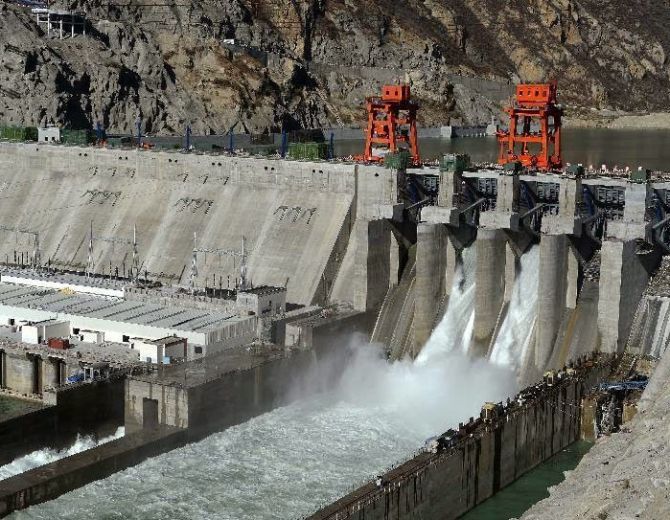The Chinese dam at Zangmu in Tibet on the Brahmaputra is now fully operational. Given China's history in the region, the construction and operationalisation of the dam has worrisome implications for India, says Sana Hashmi.

On October 13, China operationalised its first hydropower dam on the Brahmaputra river, known locally as Yarlung Tsangpo. By 2016, five other sections of the dam would also be completed, making a chain of hydro projects on the river intended to exploit the waters for hydropower generation.
The Zangmu Hydropower Station, which is one of the largest such stations in China, is located in Gyaca county of the Lhoka (Shannan) prefecture in South-eastern Tibet.
The station, believed to be positioned at the world's highest altitude, is expected to produce 2.5 billion kilowatt-hours of electricity per year.
The overall cost of the project borne by the Chinese government is a whopping $1.5 billion (approximately Rs 974 crore/Rs 9.74 billion).
Being the lesser of the two riparian countries, India is, of course, concerned about the likely fallout of Chinese activities in the long run.
The point worth remembering is that over the past few years, India has shown displeasure as well as apprehensions with respect to China's activities on the Brahmaputra.
The Inter-Ministerial Expert Group on the Brahmaputra had not reflected positively on Chinese activities on dam-building and establishing hydro power stations within 500 kilometres of the India-China border.
To alleviate India's concerns, China has officially stated that it would take India's worries in mind. For instance, Chinese foreign ministry spokesperson Hua Chunying said, 'We will take into consideration the concerns of the Indian side and will remain in contact with them.'
However, the ways and means for addressing such concerns are yet to be spelt out.
India and China signed two pacts in 2008 and 2010 which facilitated India with data on water levels and rainfall twice a day from June 1 to October 15 at three hydrological stations in Tibet.
Again, in 2013, during then prime minister Manmohan Singh's Beijing visit, an MoU was signed and China agreed to share hydrological data with India from May 15 to October 15 annually.
Though there already exists an MoU to share flood data of the Brahmaputra in the monsoon season between the two countries, there is still no formal arrangement on the issue of water-sharing.
There are at least three counts on which India should be cautious about the latest developments on the Brahmaputra.
First, China's attempt to build infrastructure in Tibet and improve its connectivity with the Chinese mainland has been one of China's major strategies, not only in terms of military preparedness but also to overcome the challenge of regional disparity.
China has been working on improving infrastructure and connectivity with the frontier states along its border. India, on the other hand, has been rather slow in developing its frontier states, with tardy development patterns.
In addition to this problem, the Brahmaputra is a major lifeline for India's north-eastern region. If the situation continues unabated, it will have long term implications for India.
Second, while the Chinese government has made it clear that it is in constant touch with the Indian authorities on the matter, it is intriguing why a robust consultative mechanism at both Track 1 and Track 1.5 involving China, India and Bangladesh has not been set up.
India needs to keep in mind that it is not the only party involved in the Brahmaputra issue. A comprehensive picture of the issue makes it evident that India is the middle riparian State, with China as the upper riparian and Bangladesh as the lower riparian State.
It is, therefore, rational for India to look for a trans-national solution to a trans-national development. This is important to ensure that at a later stage, water issues do not become an arm-twisting tool for China in dealing with the Indian states of the north-eastern region, especially Arunachal Pradesh.
Third, China's hydro-behaviour with other neighbours may serve as a key to understand its approach on the Brahmaputra as well.
Along the other two big rivers that pass through China to Southeast Asia, China has shown similar trends. On both the Lancang (upper Mekong) and Nu (upper Salween) rivers, China has carried on building dams and other associated activities without taking into account the interests and concerns of the lower riparian States.
The States affected along the Mekong and Salween includes Southeast Asian countries, namely Cambodia, Lao PDR, Myanmar, Thailand and Vietnam.
Diverting waters and being inconsiderate in its use have been the prime accusation leveled against China.
China has also maintained consistency in its response to such accusations: Denial; promise to consult; and, carry on regardless.
Clearly, India needs to bring the issue to the forefront in discussions with China, both at the Track 1 and Track 1.5 levels, while working towards stepping up infrastructure along the borders to harness the potential of the topography.
Taking lessons from Southeast Asian countries, India may also strive for a trilateral mechanism to deal with the Brahmaputra issue.
Sana Hashmi is an Associate Fellow at the Centre for Air Power Studies.









